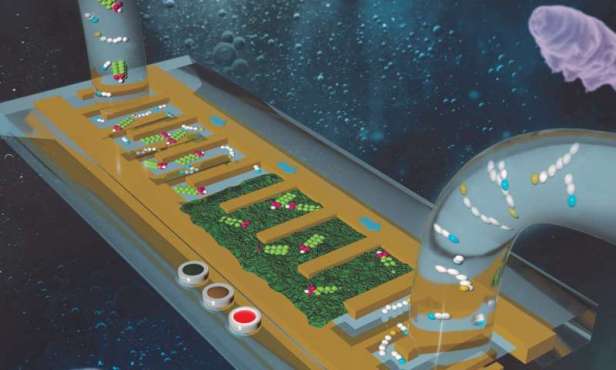Detecting toxic PFAS with a chip-sized sensor
By Kelsey Adkisson | Pacific Northwest National Laboratory (PHYS.org) | April 22, 2020

Read the full article by Kelsey Adkisson, Pacific Northwest National Laboratory (PHYS.org)
“PNNL has patented an accurate and portable way to detect miniscule amounts of an extremely persistent toxic chemical that accumulates in our bodies and our environment.
Per- and polyfluoroalkyl substances (PFAS) are hazardous, man-made chemicals used in products such as non-stick cookware, waterproof clothing, food packaging, and firefighting foam because they repel water and oils. They do not break down naturally and there is no known quick fix to destroy them. Multiple studies have linked PFAS—which stay in the environment a long time—to elevated cholesterol, obesity, weakened immune system, endocrine disruption, thyroid issues, and cancer.
The federal health advisory level for PFAS is 70 parts per trillion, roughly equal to a grain of salt in 1,000 gallons of water. Some U.S. states have even more stringent levels that are a fraction of that. The levels are so low, that water samples must be sent off to a laboratory for measurement using sensitive analytical methods. The difficulty of detecting and measuring PFAS presence quickly at the source makes remediation challenging.
PNNL researchers developed a small device to quickly and accurately measure perfluorooctanesulfonic acid (PFOS), which is a type of PFAS, with the New Jersey Institute of Technology (NJIT). The proprietary lab-on-a-chip sensor can detect PFOS levels that are two orders of magnitude lower than the federal health advisory—0.5 parts per trillion. This offers an unprecedented and convenient way to detect miniscule amounts of PFOS in water accurately, on-site, and in real time. The device is small enough, and performs fast enough, to provide point-of-use measurement data. Additionally, PNNL is expanding the device’s capability to detect all kinds of PFAS contaminants.
‘Clean water is essential. Being able to quickly identify sources of PFAS contamination is also essential,’ said Radha Motkuri, a PNNL materials scientist. ‘We envision a world where this lab-on-a-chip can be deployed immediately and broadly.’
Lab-on-a-chip PFAS Sensor
Rapid, on-site detection of super-low levels of PFAS and PFOS is a key step to protecting human health. Historically, testing takes several hours to a few days—minimum. With PNNL’s portable sensor, PFOS levels can be measured immediately on-site…”
This content provided by the PFAS Project.
Location:
Topics: